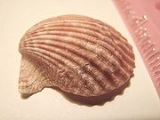
Rough scallop
Encyclopedia
The rough scallop, Aequipecten muscosus, grows up to 1.75 inches (4.4 cm). It has a small, scallop-shaped shell with about twenty strong ribs which have many erect scales or small spines near the margin. The hinge line has ears.
 The coloration of the rough scallop shell varies from pink to a dark red exterior, often mottled with colors such as brown and cream
The coloration of the rough scallop shell varies from pink to a dark red exterior, often mottled with colors such as brown and cream
, but it is also sometimes bright lemon-yellow or bright orange.
The habitat
of this species is offshore and the shell is found rarely on ocean beach
es. This species inhabits ocean waters from North Carolina
to the West Indies.
The rough scallop was frequently netted as incidental catch in commercial Atlantic calico scallop
fishery.

Cream
Cream is a dairy product that is composed of the higher-butterfat layer skimmed from the top of milk before homogenization. In un-homogenized milk, over time, the lighter fat rises to the top. In the industrial production of cream this process is accelerated by using centrifuges called "separators"...
, but it is also sometimes bright lemon-yellow or bright orange.
The habitat
Habitat
* Habitat , a place where a species lives and grows*Human habitat, a place where humans live, work or play** Space habitat, a space station intended as a permanent settlement...
of this species is offshore and the shell is found rarely on ocean beach
Beach
A beach is a geological landform along the shoreline of an ocean, sea, lake or river. It usually consists of loose particles which are often composed of rock, such as sand, gravel, shingle, pebbles or cobblestones...
es. This species inhabits ocean waters from North Carolina
North Carolina
North Carolina is a state located in the southeastern United States. The state borders South Carolina and Georgia to the south, Tennessee to the west and Virginia to the north. North Carolina contains 100 counties. Its capital is Raleigh, and its largest city is Charlotte...
to the West Indies.
The rough scallop was frequently netted as incidental catch in commercial Atlantic calico scallop
Atlantic calico scallop
The Atlantic calico scallop, Argopecten gibbus, is a species of medium-sized edible saltwater clam, specifically a scallop, a marine bivalve mollusk in the family Pectinidae, the scallops....
fishery.

